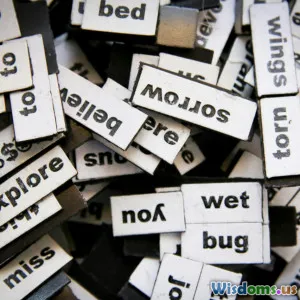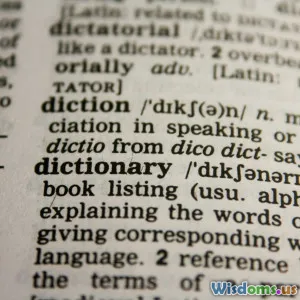
Seven Surprising Truths About Antonyms You Never Knew
14 min read Discover seven fascinating, lesser-known facts about antonyms, challenging everything you thought you knew and deepening your appreciation for language's contrasts and complexities. (0 Reviews)
Seven Surprising Truths About Antonyms You Never Knew
Introduction: Turning Words on Their Heads
Language is a marvelously complex tapestry, spun with threads of meaning interwoven into patterns of similarity and, crucially, contrast. At the heart of these patterns lie antonyms—the linguistic opposites that help us give form to our thoughts: day and night, love and hate, big and small. Mastering antonyms commonly seems like child’s play; we start matching “hot” with “cold” in elementary school, never worrying about what else might lurk beneath these simple opposites. But what if the world of antonyms is vaster and more mysterious than you ever imagined?
Get ready to challenge your assumptions. This article dives into seven surprising truths about antonyms—revealing that behind every pair of opposites, there’s a story that’s more twisty, tangled, and thought-provoking than meets the eye. Whether you’re a language learner, a trivia lover, or simply curious about the quirks that shape human communication, these insights will transform how you think about opposites forever.
1. Not All Opposites Are Created Equal: The Three Types of Antonyms
When we think of antonyms, most of us imagine a straightforward “this or that” scenario. But linguists distinguish three remarkably different categories of antonyms:
-
Gradable Antonyms: These pairs represent a spectrum or scale. For example, “hot” and “cold” have countless degrees in between, like “warm” or “cool.” You’re not just one or the other—you can be anywhere along the sliding scale.
-
Complementary Antonyms: Here, pairs have no overlap or in-between—they are binary opposites. “Dead” vs. “alive,” “on” vs. “off.” There’s no halfway point.
-
Relational (or Converse) Antonyms: These describe a relationship from opposing perspectives. For instance, “parent” and “child,” or “teacher” and “student.” Each word implies the existence of the other.
Example:
The word pair “give” and “receive” are relational antonyms—you cannot “give” without a “receiver.” Now compare with “tall” and “short”—you might be “tall” to one group but “short” for another—a gradable antonym. Finally, with “dead” and “alive,” you’re strictly one or the other—complementary antonyms.
Why Does This Matter?
Recognizing these distinctions enriches how we learn languages, write creatively, or even construct survey questions (for example, the difference between “never/always” and rating something from “terrible to excellent”). It also underscores that not all opposites are as clear-cut as they seem!
2. Some Antonyms Have No Real Opposite: The Mystery of ‘Unpaired’ Words
Have you ever noticed that words like “uncouth” have no commonly used opposite (no one says “couth”)? Or that people are “invaluable,” but we rarely hear anyone called simply “valuable” in the same sense? These are called unpaired words or loner antonyms.
Fascinating Examples:
- Ruthless: There’s no one running around being especially “ruthful.” In reality, “ruth” (meaning compassion) once existed, but faded from use.
- Disheveled: The positive—“sheveled”—has (almost) never been seen. “Sheveled,” actually cited once by a New York Times Magazine editor in 1958 as an attempt at humor, has not caught on.
- Unkempt: While “kempt” is a word, it’s extremely rare. “Kempt” (tidy) is vastly overshadowed by its opposite.
The Linguistic Quirk
Sometimes a prefix (like “un-,” “dis-,” or “non-”) attaches to a root so successfully, that the original word vanishes or the pair is never created in the first place. This sheds light on how language evolves, leaving behind ‘orphan’ words where only negativity—or positivity—remains in daily use.
Real-World Insight
Think of branding: car companies want their cars to be “reliable.” But “unreliable” is a far more common criticism in consumer reviews, perhaps due to how certain negative antonyms stick in the mind more persistently.
3. Cultural Context Shapes How 'Opposite' Is Opposite
Does “black” always mean the precise opposite of “white” cross-culturally? Not so fast! Different languages and societies divide up the spectrum of meaning in entirely unique ways.
Examples Across Cultures:
- In Russian, there are two common words for blue (“goluboy” for light blue and “siniy” for dark blue), so the antonymic divide between “blue” shades is more nuanced than in English.
- Some indigenous Australian languages, like Jirrbal, sort things by characteristics like “dangerous,” “edible,” or “related to water,” making opposites based on Western ideas (like “hot/cold”) less central.
Quote:
“Words are not mere tags for static concepts; they reflect and shape the cultural worlds we inhabit.” – Lera Boroditsky, cognitive scientist
The very idea of what constitutes an opposite can depend on what concepts a culture values or distinguishes:
- “East” and “west” seem like antonyms, but their precise implications depend on your cultural view of space and geography.
- In Japanese, “ata” and “iru” refer to presence for animate vs. inanimate subjects, meaning the concept of absence/presence is more grammatically and conceptually elaborate.
The Takeaway
What you consider 'opposite' may be completely arbitrary—or even invisible—to another culture. If you’re learning a new language, remember: antonymy isn’t universal.
4. Antonyms and Synonyms Aren’t Always Opposing Forces
It seems obvious that synonyms mean the same and antonyms the opposite, but real life is sneakier. It’s possible for two antonym pairs to share synonyms depending on context!
Surprisingly Overlapping Words:
- Cleave can mean to split apart or cling together (opposite meanings for the same word).
- In some dialects, “dust” can mean to add (as in “dusting sugar on cake”) or remove (as in “dusting the furniture”)—again, opposites with the same word.
Why Does This Happen?
Semantic drift, context, and idiomatic use mean the same words sometimes function as their own antonyms (like “sanction,” which can mean approve or punish), called auto-antonyms or contronyms.
Example:
- “Left” the party (departed) vs. “left” some cookies for you (didn’t take).
- “Oversight” can refer to supervision or accidentally missing something.
Real-World Impact
For translators and AI language models (like me), context is everything. Recognizing a word’s intended sense prevents embarrassing gaffes in translation and clarifies legal, technical, or creative writing.
5. Learning Through Antonyms Improves Comprehension and Creativity
Rote memorization of word lists is dry, but learning new vocabulary by pairing words with their antonyms boosts comprehension, critical thinking, and even emotional intelligence.
Research Fact: A 2020 study from the Journal of Educational Psychology found students who learned English word pairs using antonym context improved both word recall and nuanced understanding compared to those using synonyms only.
Examples in Practice:
- Teachers often prompt students: “What’s the opposite?” to trigger not just memory, but logical thought about gradations and categories.
- SAT and GRE tests use antonym questions (e.g., “elaborate:concise”) to test deep vocabulary knowledge.
Cognitive Benefits
When you conceptualize antonyms, your brain is forced to map categories, abstract connections, and boundaries. This makes for more agile verbal reasoning—and a bigger toolkit for expressing yourself creatively.
“ Happiness isn’t simply defined by its lack of sadness, but by the space in between. Exploring antonyms gives you mental flexibility to probe these spaces.” – [Anonymous language teacher]
Beyond Language: Life Skills
Seeing the world as a spectrum of opposites (with room in the middle!) helps foster open-mindedness—a vital skill for empathy, negotiation, and problem-solving.
6. Opposites Influence the Brain—A Neurological Surprise
Antonymic thinking is hardwired deep within us—even animals demonstrate some sense of “not X.” But research shows our brains process antonyms in specialized ways.
Neurocognitive Studies:
A landmark study in 2011 (Federmeier et al., University of Illinois) used electroencephalography (EEG) to record participants’ brain activity as they read pairs like “hot/cold,” “accept/reject,” and “day/night.” When seeing an antonym following the first word, the brain produced a distinct electric signal spike—signaling anticipation and fast recognition of the pairing.
Researchers concluded that the brain not only stores opposites together semantically, but can even “pre-activate” expected antonyms, making recognition almost instantaneous.
Real-World Effect: This neurological pairing is why jokes, poetry, and advertising slogans (“Just Do It” vs. “Don’t Quit”) grab attention and stick so well. Opposites excite patterns of memory and expectation, making messages more powerful.
Antonym Exercises for Your Brain
Try verbal games like “the opposite shop”—improvise opposite traits or objects for invented products. These boost mental agility and lateral thinking, handy skills for brainstorming sessions or creative writing.
7. Antonyms Can Disappear—or Be Created—Over Time
Language is not static; new antonyms are born, while others pass quietly into oblivion.
Disappearing Acts:
- The opposite of “wife” for much of English history was “husband.” Now, both are simply gendered pairs describing partners – neither is semantically opposite, merely counterparts.
- The word “hapless” (meaning unlucky) survives; its antonym “hapful” died out centuries ago.
Invented Antonyms in Modern Life:
- “Offline” was coined only with the advent of “online.” Neither was common a century ago.
- “Inbox” implies an “outbox”—both recent entries linked to technology.
- The diversity movement in business encouraged the creation of “inclusion” and its antonym “exclusion,” giving powerful labels to new social priorities.
Can You Make Your Own Antonyms?
Marketers, writers, and activists do this all the time—by prefixing (un-, de-, non-), or using entirely novel words. In modern slang, binary pairs like “woke”/”asleep” (socially aware/oblivious) have arisen to capture new cultural meanings.
It’s powerful proof that antonyms reflect not only linguistic needs but cultural shifts, industry priorities, technology, and social movements.
Conclusion: Embracing Contrasts Beyond the Obvious
Antonyms go far beyond matching flashcards in second-grade spelling class. They frame how we think, converse, and even perceive the world around us. Their quirks—unpaired loners, shifting cultural meaning, neural pairings, and creative inventions—remind us that language is both rule-bound and deeply human.
The next time you reach for a handy opposite, recall these seven truths and appreciate the ingenuity, adaptability, and surprise that antonyms bring to words, ideas, and ultimately, your own worldview. After all, it’s in contrast, not just similarity, that the full story of language—and life—unfolds.
Further Reading & Resources
- Pinker, Steven. The Sense of Style: The Thinking Person’s Guide to Writing in the 21st Century
- Boroditsky, Lera. “How Language Shapes Thought,” Scientific American, 2011
- University of Minnesota. “The Types and Functions of Antonyms,” Linguistics Department lecture materials
- Lexico.com: “What’s the Opposite of...?”
Rate the Post
User Reviews
Popular Posts

















